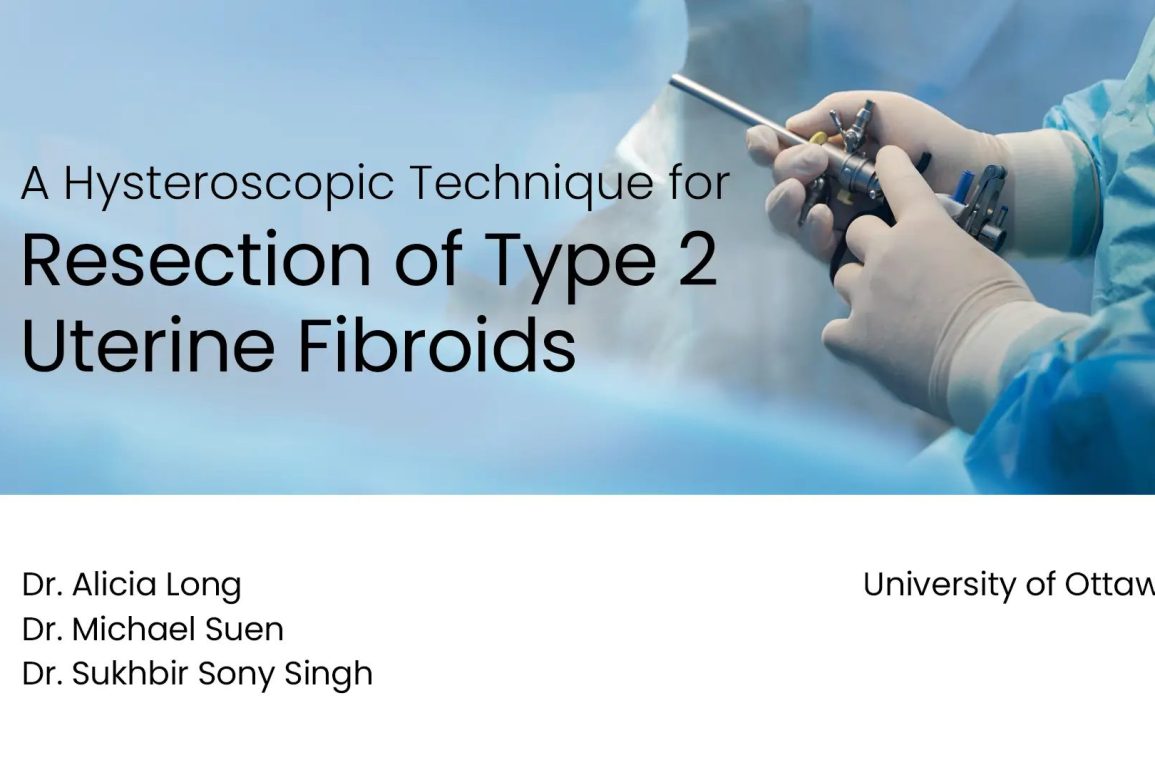Table of Contents
- Procedure Summary
- Authors
- Youtube Video
- What are Fibroids?
- What are the Risks of Fibroids?
- Video Transcript
Procedure Summary
- The FIGO classification system for fibroids is based on the location of the fibroid relative to the myometrium.
- The Type Zero, One, and Two submucosal fibroids can be accessed and resected hysteroscopically.
- Indications for resection of submucosal uterine fibroids include heavy or abnormal uterine bleeding, infertility or subfertility, and recurrent pregnancy loss.
- Complications associated with hysteroscopic resection of fibroids include bleeding, infection, fluid balance complications such as hyponatremia, uterine perforation, and uterine scarring and adhesion formation.
- Advanced surgical planning is essential to minimize complications. Pre-operative medical optimization may include options such as ulipristal acetate, leuprolide, and iron supplementation.
Presented By


Affiliations
See Also
What are Fibroids?
- Fibroids are noncancerous growths in or on the uterus that are common in women during their reproductive years.
- Classified by FIGO from Type Zero to Eight based on their location in the uterus. Submucosal fibroids include Type Zero, One, and Two.
- Symptoms may include heavy menstrual bleeding, pain, and fertility issues. Submucosal fibroids can cause heavy bleeding and fertility problems.
- Treatment includes removing submucosal fibroids using a minimally invasive procedure called hysteroscopic myomectomy.
What are the Risks of Fibroids?
Not all women with fibroids have symptoms, but when they do, they can be severe and can interfere with the quality of life. The risks and complications associated with fibroids can include:
-
Heavy menstrual bleeding: One of the most common symptoms associated with fibroids is prolonged and heavy menstrual bleeding, which can lead to anemia, causing fatigue and weakness.
-
Pain and discomfort: Depending on their size and location, fibroids can cause pain or a feeling of heaviness in the pelvic area. They may also cause pain during intercourse.
-
Reproductive issues: Fibroids can cause complications with fertility, pregnancy, and childbirth. They might lead to difficulty in conceiving (although they are not the primary cause of infertility), increase the risk of miscarriage, or influence the position of the fetus, potentially leading to a need for a C-section.
-
Pressure on other organs: Large fibroids can exert pressure on surrounding organs, such as the bladder, leading to frequent urination, or the rectum, causing constipation. Sometimes, they can also cause back pain or leg pain.
-
Rare malignant transformation: There is an extremely low risk of fibroids transforming into a cancerous growth called leiomyosarcoma. However, this is very rare.
-
Hydronephrosis: This condition occurs when a fibroid compresses the ureter, leading to swelling of the kidneys. It requires immediate medical attention.
-
Complications in pregnancy: Besides fertility issues, fibroids can cause problems during pregnancy such as a risk of preterm birth, breech birth, or postpartum hemorrhage. They can also necessitate a cesarean section or lead to complications after childbirth.
-
Emotional and psychological impact: Living with the symptoms of fibroids, like heavy periods and chronic pain, can negatively affect a woman’s quality of life, potentially leading to anxiety, depression, or stress.
It’s important for women with fibroids to maintain regular gynecological care. Treatment can range from observation for those without symptoms to medication and potentially surgery for those experiencing significant effects. The choice of treatment depends on various factors including the size and location of the fibroids, the severity of symptoms, the woman’s age, and whether she plans to have children in the future. Always consult with a healthcare professional for the best course of action.
Watch on YouTube
Click here to watch this video on YouTube.
Video Transcript
This video will demonstrate a hysteroscopic technique for resection of Type Two uterine fibroids. The learning objectives include understanding the classification system of fibroids, listing the indications for hysteroscopic resection, reviewing the complications of operative hysteroscopy, reviewing the peri-operative optimization for hysteroscopic myomectomy, and demonstrating a unique surgical approach to the resection of a Type Two uterine fibroid using a case example.
Understanding the FIGO Classification System of Fibroids
According to the FIGO classification system, fibroids, or leiomyomas, can be classified from Type Zero through Eight. This classification system is based on the location of the fibroid relative to the myometrium. Submucosal fibroids, or Type Zero, One and Two, are those which are in contact with the endometrium. These can be accessed and resected hysteroscopically. Imaging modalities that allow us to classify fibroids include ultrasound, saline infusion sonohystogram, MRI and visual diagnosis at the time of hysteroscopy.
Visual Classification of Submucosal Fibroids
Type Zero Fibroids
You may be wondering how we can visually classify submucosal fibroid. Type Zero fibroids are those that are completely intracavitary, pedunculated, and the angle between the stalk of the fibroid and the myometrium is less than 20 degrees. Here is an example of a Type Zero fibroid. As you can see, the angle from the base of the fibroid to the myometrium is less than 20 degrees.
Type One Fibroids
With respect to Type One fibroids, less than 50% of the volume of the fibroid resides within the myometrium. Therefore, the base of the fibroid and the myometrium form an angle between 21 and 90 degrees. With a Type Two fibroid, greater than 50% of its volume resides within the myometrium. Therefore, the base of the fibroid forms an angle with the myometrium that is greater than 90 degrees.
Type Two Fibroids
Here is an example of a Type Two fibroid. As you can see, the base of the fibroid forms an angle with the myometrium of greater than 90 degrees. It should be noted that at the time of hysteroscopy, overdistention of the uterus with fluid medium may force the fibroid into the wall of the myometrium, and the true size of the fibroid might be underestimated.
To assess the fibroid as it would occur in its native state, one can decrease intracavitary pressure by decreasing the flow of the fluid medium. You then may see the fibroid budding from the myometrium into the cavity. It is important to know the size of the fibroid when attempting hysteroscopic resection.
Indications for resection of submucosal uterine fibroids include heavy or abnormal uterine bleeding, infertility or subfertility and recurrent pregnancy loss. The complications associated with hysteroscopic resection of fibroids include bleeding, infection, fluid balance complications such as hyponatremia, uterine perforation and uterine scarring and adhesion formation.
Asherman’s Syndrome and Hysteroscopic Adhesiolysis
This video demonstrates hysteroscopic adhesiolysis of intrauterine scar tissue. Asherman’s syndrome is defined as intrauterine adhesions which partially or completely obstruct the uterine cavity. This syndrome can be associated with abnormal uterine bleeding, infertility and recurrent pregnancy loss.
Surgical Approach to Resection of Type Two Uterine Fibroids
Therefore, it has been suggested that during hysteroscopic myomectomy, damage to the endometrium be minimized. We will now describe a surgical approach that has not been well described in the literature but may decrease the incidence of intrauterine adhesion formation.
This animation demonstrates a Type Two fibroid as it would be visualized at the time of hysteroscopy.
Step one is to use the electrosurgical hysteroscopic resectoscope to make a curvilinear incision at the lower border of the fibroid to access the fibroid capsule.
Step two is to continue developing the endometrial flap, which is done by incising in the plane between the endometrium and the fibroid capsule, and continuing to push the flap up and out of the way and exposing the fibroid.
Step three. Activate the current on the resectoscope and resect the fibroid in long strokes until healthy myometrial tissue is encountered. Once the resection is complete, the endometrial flap will lay over the defect, thereby preventing future intrauterine adhesion formation.
Case Example: Demonstrating the Novel Surgical Approach
We will now demonstrate this same approach using a case example, a 35-year-old gravida one, para zero who presented with secondary infertility over the past four years, as well as a second trimester spontaneous abortion. She also had a history of heavy menstrual bleeding and dysmenorrhea. She was found to have a Type Two uterine fibroid on imaging and completed a three-month course of ulipristal acetate. Her haemoglobin was optimized on iron preoperatively.
This pelvic ultrasound of our case patient demonstrates a 4.0 by 4.6 by 4.3 cm uterine fibroid in the posterior fundus of the uterus. The distance between the fibroid and the serosa of the uterus is 7.75 mm. Here, we demonstrate our case patient who has a Type Two uterine fibroid.
Surgical Steps
Again, step one is to undermine the endometrium, which is done by activating the current on the resectoscope and incising in a curvilinear fashion. Ideally, this incision should be made in a curve, not in a straight line. This allows us to create a flap which can be elevated off the fibroid capsule.
Once the initial curvilinear incision is made, step two is to develop the endometrial flap. As you can see, the current is activated in short bursts, allowing dissection along the plane between the endometrium and the fibroid capsule. Development of the endometrial flap is important to have adequate visualization and space for resection of the fibroid. The resectoscope can also be used without the current activated, to provide visual and tactile feedback.
Once the fibroid has been adequately exposed, it can now be resected. This is performed by activating the electrical current and moving from cephalad to caudad in long strokes. Of note, the current should always be deactivated when moving the resectoscope from caudad to cephalad to avoid inadvertent uterine perforation.
Surgical Technique
Here you can see the technique of pushing fragments of fibroid up and out of the way so that the resection can continue without removing each piece, as this decreases efficiency, increases operative time and increases the amount of fluid absorbed.
Continue to resect the fibroid tissue until healthy myometrial tissue is reached, being cautious and mindful of the distance between the fibroid capsule and serosa of the uterus that we observed in the patient’s ultrasound. This is why advanced surgical planning is essential, and ideally, ultrasound images should be reviewed preoperatively.
Final Outcome and Minimized Risk of Scar Tissue Formation
The final product demonstrates the fibroid which has been completely resected and the endometrial flap which overlies the defect. This should ultimately decrease the risk of scar tissue formation, which can lead to complications such as Asherman’s syndrome.
Final considerations involve the peri-operative optimization of hysteroscopic myomectomy. Pre-operative medical optimization includes options such as ulipristal acetate, leuprolide and iron supplementation.
As we alluded to earlier, advanced surgical planning is essential. This includes reviewing the ultrasound images to determine the type of fibroid and the distance between the fibroid capsule and the serosa to avoid full-thickness transection of the myometrium.
Minimizing Intraoperative Complications
Steps can be performed intraoperatively to minimize complications, such as the usage of intracervical vasopressin and intraoperative administration of tranexamic acid.
Review of Learning Objectives
To review, our learning objectives were to understand the classification system for fibroids, list the indications for hysteroscopic resection of fibroids, review the complications of operative hysteroscopy, review the peri-operative optimization for hysteroscopic myomectomy, and to demonstrate a surgical approach to resection of a Type Two uterine fibroid using a case example.



